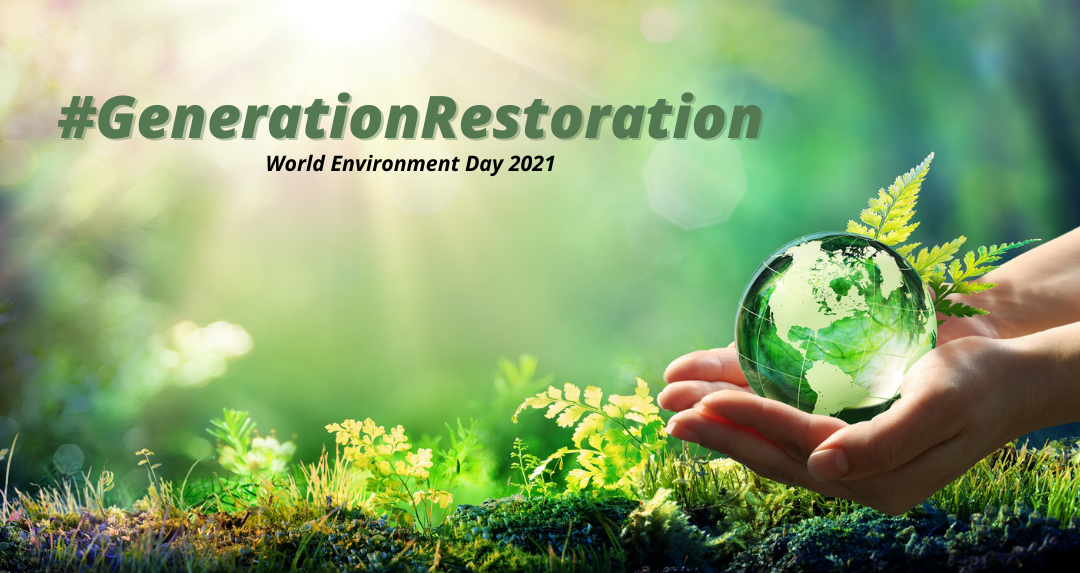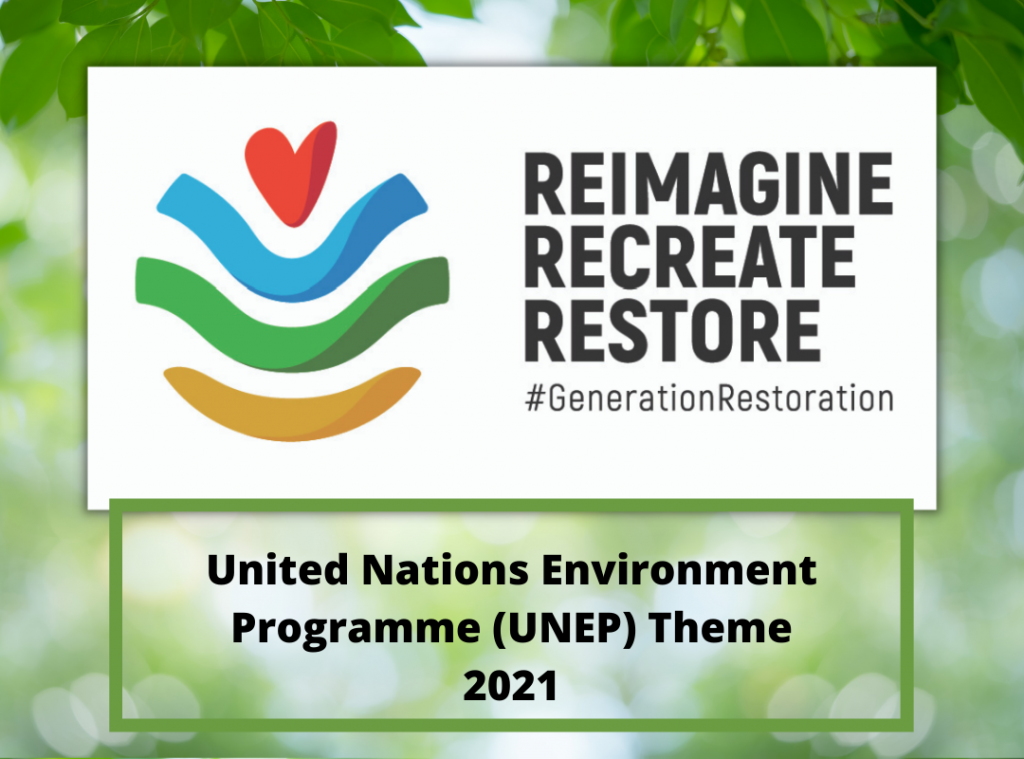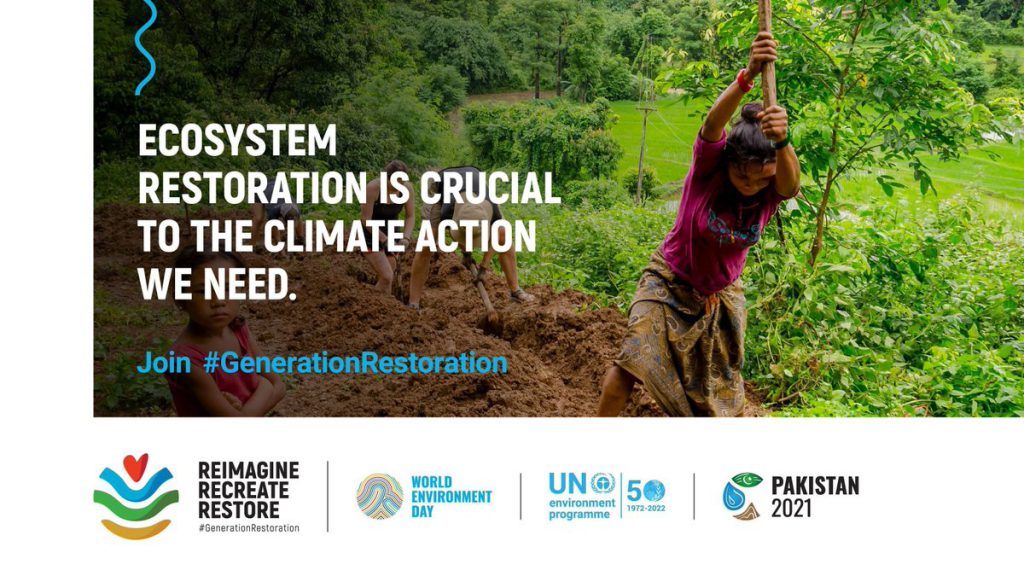
The time to just conserve is gone. Now the time is to restore life on Earth. It’s time to reimagine, recreate and restore! This World Environment Day 2021, are you ready to act for nature?
Preventing greenhouse gases. Planting more green. Stop cutting trees. Stop plastic usage… Gen X, Millennials and Gen Z have become used to these phrases. Conserve is the word we all have literally grown up with. But what this generation needs now is a new word. RESTORE!

Nature has changed. Isn’t it time for us to change our behaviour, our actions and our understanding of our environment? Well, the United Nations Environment Programme (UNEP) says the time is NOW! Our home, our planet Earth needs our help. Every year, the UN comes up with an action plan and an idea to conserve and preserve our environment. This time, the United Nations has declared this decade 2021-2030 as a sprint back to Ecosystem Restoration.
The rate at which we humans are using and abusing the resources, at this moment we need 1.8 Earths to sustain this life force.

The climatic emergencies and the loss of nature are not only eliminating millions of species but destroying our home too. But we will not back down. This time nations around the world have decided to stand, act and convert. This degradation is verily evitable. We have all the knowledge and power to reverse the harm done, and reclaim a peaceful life on Earth. – If we act NOW.
What is Ecosystem Restoration?
This World Environment Day 2021, #GenerationRestoration is the hashtag that is breaking the internet! This new generation of ecopreneurs known as Generation Restoration is all about putting our Earth on top priority! Beginning this day, people, nations and organizations on all levels are coming together with utmost force and intent to reverse the damage done. UNEP defines Ecosystem Restoration as “a process of reversing the degradation of ecosystems, to improve the productivity and capacity of ecosystems to meet the needs of society.”
The motto for the decade is to reimagine, recreate and restore our nature back to its real beauty and life! And everything needs a plan and focused actions.
Following 7 ecosystems are the focus of this mission for the decade that will decide our fate with the environment.
-
Forests and Trees
Forests provide life to millions and billions of flora and fauna. But lately, incidents like the recent Australian forest fire have left the jungles bleeding. But the steps towards reversing the damage is commendable too. This year’s World Environment Day host country, Pakistan has come up with one of the world’s most ambitious afforestation efforts with the “10 Billion Tsunami Tree” drive. Let’s support this endeavour and help restore the green belts!
-
Rivers and Lakes
Rivers and lakes supply food, water and energy to billions of people, along with providing unique habitat to a third of all the vertebrate species. More than half of the free-flowing freshwater is bounded by dams and clogs. But many initiatives like the “Adopt a River” campaign across the globe are bringing a much-needed reversal in the damage.
-
Towns and Cities
Towns and cities occupy less than 1 per cent of the Earth’s surface but house most of its people. Steps like greener public ecosystems and creating more organic spaces in our personal homes, like terrace garden also adds to the solution. Each step counts!

-
Oceans and Coasts
Covering almost 70% of the Earth’s surface and providing us with most of the oxygen that we breathe, oceans literally hold our lives in their hands! Cleaning up the beaches, restoring on and under the ocean vegetation are a few basic steps that we can take to restore our bank of life in these oceans.
-
Farmlands and Grasslands
Our most valuable ecosystem, undoubtedly! Agricultural lands and grasslands nurture and nourish us in all possible ways. Moving towards organic from chemicals, and bringing back the indigenous are the calls that nature wants us to make. Now!
-
Mountains
Mountains and hills are sensitively affected by the degradation from human pressures and undue climate change. Restoring forest shields and limiting extractions are a few steps that can help regain the strength of mountains that holds together the balance between a plethora of ecosystems.
-
Peatlands
Peatlands are terrestrial wetland ecosystems in which waterlogged conditions prevent plant material from fully decomposing. Why are these important? Because they take up not more than 3% of space but store more than 30% of soil carbon in it. Taking measures to protect these peatlands would promise a better balance in the ecosystem.
This is our moment.
Once gone, time would not turn back. What can we do as individuals?
We can grow trees.
Help keep our locality clean.
Create and flourish new gardens.
Eat and use only as much as needed and avoid wastage.
Volunteer to clean up rivers and coasts.
There are gazillion things that each one of us can do, alone too! We are the generation that can and HAS TO rebuild our relation with nature and save humanity by saving our ecosystem!
It’s about being active, not anxious. To be bold and make that first move!
We are the #GenerationRestoration.










